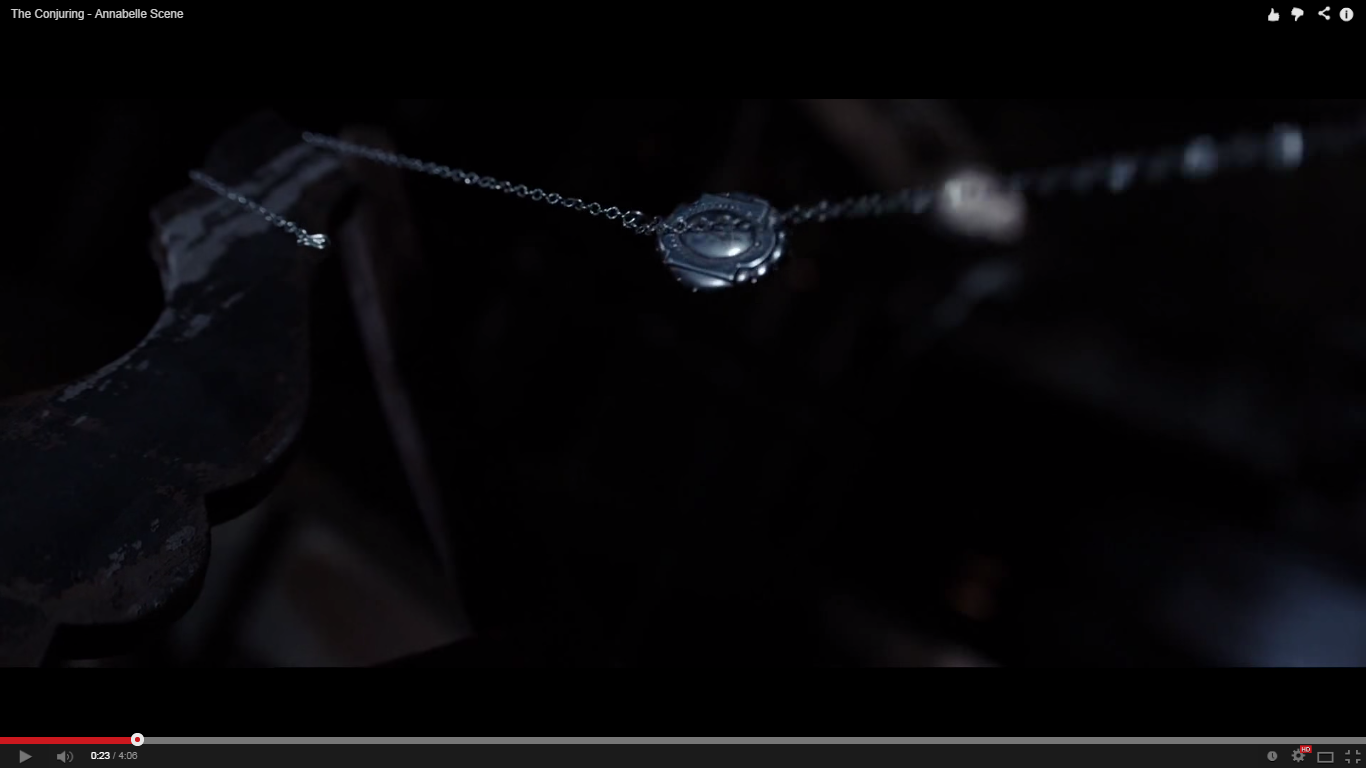Research Into Editing Styles
Editing within films is a the process where a variety of clips are collected and eventually merged together, with the use of a variety of different techniques. The techniques I'm going to be exploring are, jump cuts, timing of shots and fades; 'the conjuring' clip will help enhance my research as I will explore and relate these particular techniques to this clip (http://youtu.be/wljn4_pzxbg).
'The Conjuring'- Annabelle scene
Timing Of Shot
 During the start of the clip a pendant is the soul focus for around 23 seconds. This is a long duration of time to focus on only one object. The vast length of this shot presents to the audience the importance of the pendant. It also introduces a sense of foreboding for what the is about to happen in the film based around the pendant. This slowly progressive shot is included to allow enough time for the audience to become aware the importance on the pendant. Thus leaving them gripped and tense as they analyse the images on screen. A pendant is also know for being wore around the neck and placed close to the heart. This may then connote that the pendant is the heart of the problem/s about to commence. Such connotations and slow pace leave the audience searching for answers and riddled with an uneasy feeling, as they anticipate something bad happening. The imagery enhanced by the slow timing of the shot is classic of the thriller genre. This is because it builds tension whilst educating the viewer of the importance of what is being presented.
During the start of the clip a pendant is the soul focus for around 23 seconds. This is a long duration of time to focus on only one object. The vast length of this shot presents to the audience the importance of the pendant. It also introduces a sense of foreboding for what the is about to happen in the film based around the pendant. This slowly progressive shot is included to allow enough time for the audience to become aware the importance on the pendant. Thus leaving them gripped and tense as they analyse the images on screen. A pendant is also know for being wore around the neck and placed close to the heart. This may then connote that the pendant is the heart of the problem/s about to commence. Such connotations and slow pace leave the audience searching for answers and riddled with an uneasy feeling, as they anticipate something bad happening. The imagery enhanced by the slow timing of the shot is classic of the thriller genre. This is because it builds tension whilst educating the viewer of the importance of what is being presented. Fade- In
To open the Annabelle scene a fade in has been used. This is when the screen gradually changes from a single colour, in this case black, and the picture begins to appear on screen. This fade is relatively slow and mirrors a tired opening of eyes. This is a perfect way to open the scene as the little girl 'Judy' is clearly fast asleep, however the shot forebodes her sudden wake up a few seconds later.The fade gives the audience a prolonged view of the action, leaving them in suspense. This enhanced suspense and ambiguity created for the audience is classic of a thriller film as, it leaves them anticipation for what terrors my befall them next.
Jump Cut
A jump cut is a sudden transition from one image to another. In this clip the first obvious jump cut is when the 'Judy' is shown down the hall as the lights begin to switch themselves off, and then cuts to a shot behind her, focusing on the door slam. This swift jump cut during 'Judy's sheer panic displays how the situation in not over and she cannot loose what ever it is following her, simply by slamming the door. The shot emphasizes this as the she is presented from the back, as though someone is behind her, still following her every move. Also a jump cut from the 'Judy' in a state of terror, screaming for her grand mother, to her grand mother is introduced. This allows the audience to grasp not only 'Judy's terror, but the fear for the child's safety the grandmother displays. The swift transitions from both characters allow the viewer to build a relationship with each of them. As well as this, from showing different character perspectives it leaves the audience with a sense of empathy, as they have witnessed the struggle and fear upon the faces of the characters. The sharp pace and tension displayed through the prevalent jump cuts are presented in any typical thriller. This is because, the audience are left dazed by the many different aspects of the traumatizing situation and therefore, gripped to pursue a clear explanation.
In summary, all of these styles of editing are essential to create a progressively tense atmosphere. I feel of the shots have an element of simplicity to them ans this has inspired me for my future thriller film. Before I had researched into editing styles, such elements as timing had even crossed my mind. I'm aiming to hopefully include all of these editing styles in order to create an interesting viewing from a variety of perspectives.


This post demonstrates a good understanding of how editing styles are used within the thriller genre. The examples that you have included, help to support your understanding of the editing styles well. You have made a start in considering the codes and conventions of a thriller, but these points need to be elaborated further, to demonstrate further understanding.
ReplyDelete